The Effect of Strong Magnetic Field on Heavy Quarkonia in a Hot Medium Using Nikiforov-Uvarov Method
M. Abu-shady*  and H. M. Fath-Allah
and H. M. Fath-Allah
1Department of Mathematics and Computer Sciences, Faculty of Science, Menoufia University, Egypt .
2Higher Institute of Engineering and Technology, Menoufia, Egypt .
Corresponding author Email: dr.abushady@gmail.com
DOI: http://dx.doi.org/10.13005/OJPS06.01-02.04
Copy the following to cite this article:
Abu-shady M, Fath-Allah H. M. The Effect of Strong Magnetic Field on Heavy Quarkonia in a Hot Medium Using Nikiforov-Uvarov Method. Oriental Jornal of Physical Sciences 2021; 6(1,2). DOI:http://dx.doi.org/10.13005/OJPS06.01-02.04
Copy the following to cite this URL:
Abu-shady M, Fath-Allah H. M. The Effect of Strong Magnetic Field on Heavy Quarkonia in a Hot Medium Using Nikiforov-Uvarov Method. Oriental Jornal of Physical Sciences 2021; 6(1,2). Available From: https://bit.ly/3xPAkvG
Download article (pdf) Citation Manager Publish History
Select type of program for download
| Endnote EndNote format (Mac & Win) | |
| Reference Manager Ris format (Win only) | |
| Procite Ris format (Win only) | |
| Medlars Format | |
| RefWorks Format RefWorks format (Mac & Win) | |
| BibTex Format BibTex format (Mac & Win) |
Article Publishing History
| Received: | 13-11-2021 |
|---|---|
| Accepted: | 26-11-2021 |
| Reviewed by: | 
 Fateh Mebarek-Oudina
Fateh Mebarek-Oudina |
| Second Review by: |

 Praveen Agarwal
Praveen Agarwal |
| Final Approval by: | Dr J. Ajayan |
Introduction
In the mid-seventies, scientists investigated the possibility of quark-gluon plasma (QGP).1,2. The URHIC events have recently been reported when the magnetic field effect is combined with an exceptionally strong magnetic field3-7. The strength of the magnetic field is dependent on the centrality and could be between mπ2 (?1018 Gauss) at RHIC8 to 10 mπ2 at LHC 1. It is capable of achieving levels in extreme situations. 50 mπ2. The Higgs field gradients rendered an extraordinarily enormous magnetic field (∼1023 Gauss), during the electroweak stage transition in the early cosmos 9.
The dissociation of quarkonia necessitates the measuring of heavy quarkonium potentials in a disordered manner.10,11-13. Over the last two decades, the dynamics of the dissociation of quarkonium have been seen in a medium where, in the beginning, the resonance was assumed to be dissociated if screening is robust enough, i.e. potential is too small to keep pair appointed by QQ. Dissociation is currently considered primarily to be due to the increase in the resonance distance either due to an inelastic mechanism of spatially mediated dispersion by a patron such as gluons, known as Landau damping14, or because of a process glue-dissociation in which involves hard thermal gluon in one-tone color state15. In serval approach models, the effect of eB on QCD thermo-dynamics has been examined16-38.
A few studies have looked into the effect of magnetic fields on the static characteristics of quarkonium.10,39-45. One of the study influences on the features of nuclear matter under extreme settings has been heavy quarkonia., as quarkonia form in URHICs field as at a very period of ∼1/2mQ (where mQ is mass of charm or bottom quark), this is equivalent to time scale at which magnetic field is produced. In presence of an external magnetic field, vacuum quantum with harmonic oscillators and Cornell potential39,42 were recently mechanically investigated with quarkonium and heavy meson spectroscopy, with an additional spin-spin interaction component. The effect of finite T and eB on the real part of QQ potential in form of destructive thermal QCD & dissociation of heavy quarkonia due to color screening have been studied46. In Ref.16, the real part of the potential is included in SE in order to determine energy eigenvalues and energy eigenfunctions of the states of the cc. On the other hand, the magnetic field pays an important in the non-fluid mechanics such as in Refs.60-63
The aim of the present work, we have analytically solved the Schrodinger equation using NU method in which the finite temperature and magnetic field are included in the potential interaction. For our best knowledge, the previous works are not solved the present potential analytically. In addition, the effect of a number of flavors is studied on the binding energy and dissociation temperature of quarkonium.
This paper is organized as follows. In Sec. 2, we describe NU method. In Sec.3, the method is used to solve N-dimensional SE. In Sec. 4, we discuss the results, and a summary & conclusion are given in Sec.5.
Theoretical Method
The NU method 47 used to solve the second-order differential equation in form is defined as follows

where σ(s) and σ(s) are max-second degree polynomials and τ(s) is the first-degree maximal polynomials. By using the transformation of s = s (r),

as in Ref.48, Eq. (1) can be written

where,

where π(s) is the first-degree polynomial 47
and

then, the new eigenvalue equation becomes

x(s) = xn(s) is an n degree polynomial which fulfils the form of the Rodrigues

where Bn is a constant of normalization and ρ(s) is a function of weight that follows the next equation


and

π(s) is a first degree polynomial. The K in square-root of Eq. (9) is possible to determine whether expression under square root is square of expression. This is possible if the discrimination is zero.
The Solution of the Schrödinger Equation in the Presence of a Strong Magnetic Field.
As in Ref.49, in N-dimensional space, the Schrödinger equation for two particles which interact with symmetrical potentials takes form

Where l, N & μ are angular momentum quantum numbers, dimensional numbers, & reduced mass. Following radial, SE is obtained by applying the wave function

In the present work, the radial Schrödinger equation is employed which means potential interaction is symmetry. So, the potential takes the following form as in Ref.50. This potential depends on the radial distance. The effect of the magnetic field will be appearing through the Debye mass. In addition, the anisotropy in the present potential with respect to the direction of the magnetic field is not breaking the translational invariance of space, (for detail, see Ref.46).

where,
the string tension σ = 0.18 GeV2 in Ref.16

where,
Nc is the number of colors, MB (~ 1 GeV) is an infrared mass which is interpreted as the ground state mass of the two gluons bound to by the basic string, μ0 = 1.1 (GeV), ΛV = 0.385 (GeV) as in Refs.51-53 and the Debye mass53 becomes

where,
the first term is the contribution from the gluon loops and dependent on temperature and the magnetic field doesn't affect it. The second term is this term strongly depends on the eB and is not much sensitive to the T of the medium. In the first term, where g is the running strong coupling and is given by

where,
αs(T) is the usual temperature-dependent running coupling. It is given by

where,
Nf is the number of flavors, Λ is the renormalization scale is taken as 2 π T and ΛQCD~ 0.2 (GeV) as in Ref.16.
The second term is g =3.3, qf is the quark flavor f = u and d, B is the magnetic field, β is the inverse of temperature and quark mass massive mf = 0.307 (GeV) as in Ref.54. In Eq. (13), e- mD r is expanded up to second-order where mD r << 1 is considered as in55. Eq. (13) is written as follows

where,



By substituting Eq. (18) into Eq. (12), we get

By using r = 1/x and r0 is the characteristic meson radius. So we could rewrite Eq. (22) as in Ref.56

The scheme is then based on 1/x extensions r0, y=x-δ and power series around y=0 where δ is a free parameter. Then, we have the scheme.


Substituting Eqs. (24) into Eq. (23), we get

where,



By comparing Eq. (25) and Eq. (1), we obtain τ (s) = 4x , σ(s) = x2 and σ(s) = 2( - A1 +B1x - C1x2). Hence, Eq. (25) fulfils Eq. (1), therefore, the following NU method as in Sec. 2,

Constant K is selected as it has a double zero under the square root, i.e. its discriminate ? = 4B1 - 8 A1(1+K + 2 C1 ) = 0. Hence,

Thus,

In the above equation, we select the positive sign to have a derivative

using Eq. (10), we get

and Eq. (6), we obtain

From Eq. (6), λ = λn

Let,  then the equation becomes quadratic
then the equation becomes quadratic

The Eq. (36) is solved, we get the spectrum of energy

Results and Discussion
We note that Debye screening depends on eB and T. In Fig. (1), we find mD increases with the temperature linearly and the effect the Nf plays a role in increasing the Debye mass with temperature. In the left panel, when mf > T and T2 < eB, the Debye mass increases with temperature. In the right panel, when mf< T and T2 < eB, the Debye mass increases with temperature and we note that the quark mass does not affect the Debye mass. This conclusion is in an agreement with Ref.57
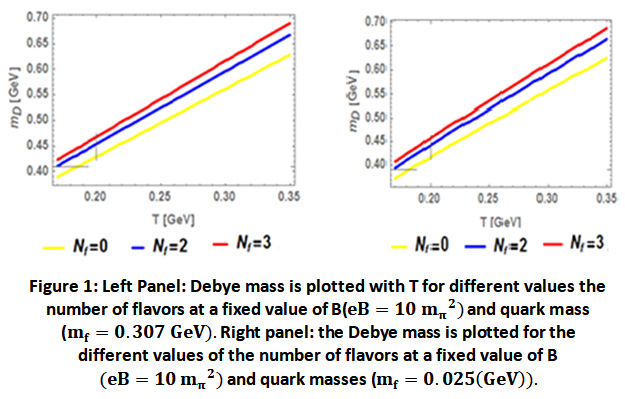 |
Figure 1: Left Panel: Debye mass is plotted with T for different values the number of flavors at a fixed value of B(eB=10 mπ2) and quark mass (mf=0.307 GeV). Right panel: the Debye mass is plotted for the different values of the number of flavors at a fixed value of B (eB=10 mπ2) and quark masses (mf=0.025GeV). Click here to view Figure |
In Fig. (2), we note that mD increases with T and increases the number of flavors. In the left panel, when mf> T, T2 < eB, the Debye mass increases with increasing temperature. In the right panel, when mf < T and T2 < eB, the Debye mass increases with increases to temperature. Therefore, we noted that increasing the magnetic field up to 15 mπ2 is not affected the behavior of the Debye mass. Also, this conclusion is in agreement with Ref.16.
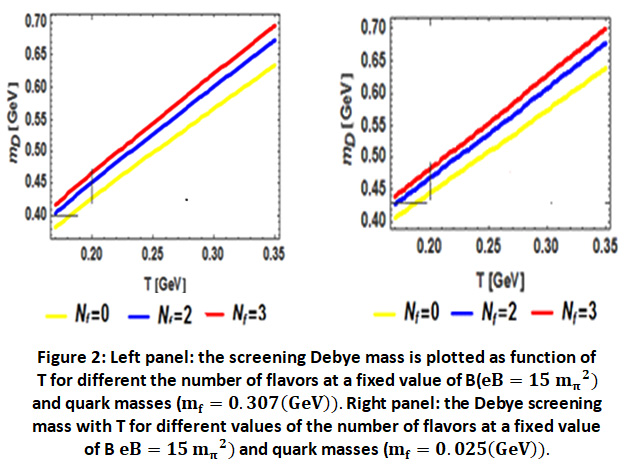 |
Figure 2: Left panel: the screening Debye mass is plotted as a function of T for different the number of flavors at a fixed value of B(eB=15 mπ2) and quark masses (mf=0.307GeV). Right panel: the Debye screening mass with T for different values of the number of flavors at a fixed value of B eB=15 mπ2) and quark masses (mf=0.025GeV). Click here to view Figure |
In Fig. (3), in the left panel the mD increases with increasing T and eB with (NF=2) and quark masses massive (mf=0.307(GeV)). We show that the mD increases linearly both with T & eB. We took quark masses mass (mf=0.025(GeV)). In the right panel, we have plotted Debye screening mass with temperature and magnetic field B with (NF=2), we find that the quark mass does not affect on the Debye mass.
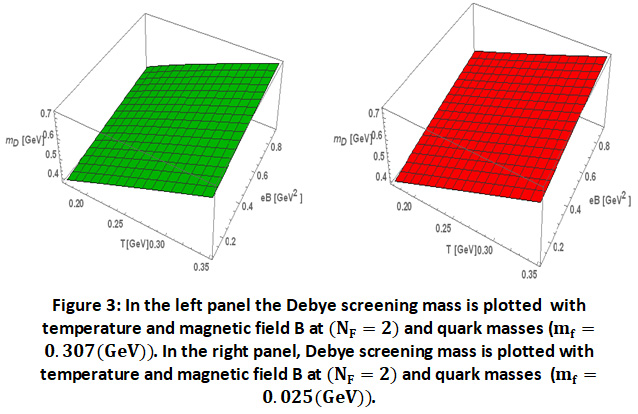 |
Figure 3: In the left panel the Debye screening mass is plotted with temperature and magnetic field B at (NF=2) and quark masses (mf=0.307(GeV)). In the right panel, Debye screening mass is plotted with temperature and magnetic field B at (NF=2) and quark masses (mf=0.025(GeV)). Click here to view Figure |
In Fig.(4), we have plotted Debye screening mass with temperature and magnetic field B with (NF=0, NF=2) and quark masses (mf=0.307(GeV)). We show that the mD increases linearly with both T and eB. By increasing the number of flavors, the Debye mass increases with temperature and magnetic field.
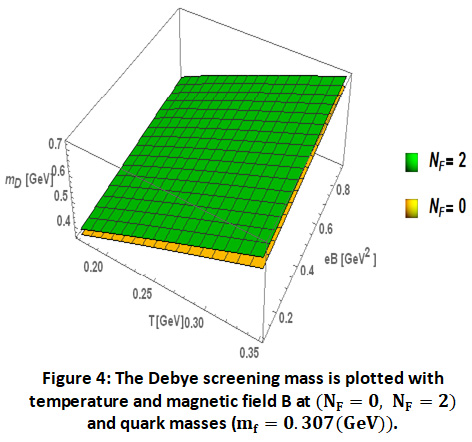 |
Figure 4: The Debye screening mass is plotted with temperature and magnetic field B at NF=0, NF=2 and quark masses (mf=0.307(GeV)). Click here to view Figure |
Also, in this section, we note comportment of real potential that shows a fundamental role in current work. Quark-antiquark interaction potential has plotted a function of distance (r), where the T and eB is included in the potential through the mD. The Debye screening mass is parameterized according to Eq. (15) in which Nc =3, Nf=2 and g = 3.3 are taken.
In Fig. (5), in the left panel, we plotted real part of potential as a function of r for different values of the magnetic field like eB=10 mπ2, eB=25mπ2 and eB=50mπ2 at the fixed value of temperature T=Tc. We noted that when value of eB is increased the real-part is more screened. We noted that the (eB=10mπ2) has an effect on the linear term. However, a further increase of magnetic field (eB=25mπ2) and (eB=50mπ2) the potential becomes more attractive than eB=10mπ2. In the right panel, we have plotted real part of potential as function of different temperature values like T=1.5 Tc, T=2 Tc, and T=3 Tc for a fixed value of eB=10 mπ2. We have seen that the potential is screened by increasing the temperature. As a result, the real part of potential was found to be more screened to increase value of both T & eB. This conclusion has been agreed with Ref.16.
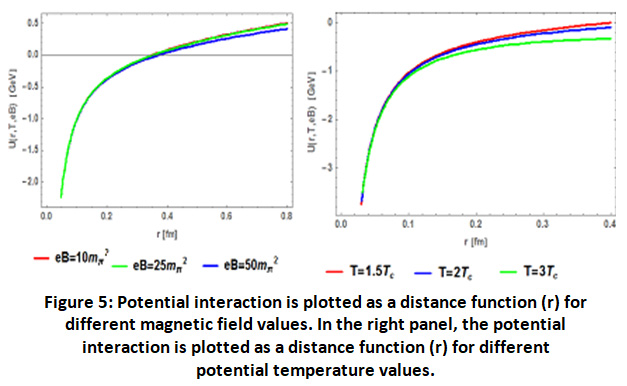 |
Figure 5: Potential interaction is plotted as a distance function (r) for different magnetic field values. In the right panel, the potential interaction is plotted as a distance function (r) for different potential temperature values. Click here to view Figure |
In Fig. (6), we have plotted real part of potential as function of the temperature and the magnetic field for the fixed value of r = 0.2 fm. To see the change of the potential with the strong magnetic field for the temperature range T= 0.17- 0.3 GeV, we notice that potential is more attractive with a magnetic field than temperature. This conclusion is in agreement with58.
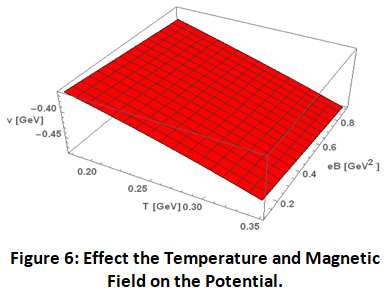 |
Figure 6: Effect of the Temperature and Magnetic Field on the Potential. Click here to view Figure |
Binding Energy
By solving Schrodinger equation as discussed in Sec. 3. We need to mention that the radial Schrödinger equation is numerically solved as in Refs.46,50. We obtain the BEs of cc and bb. In following, we see the change of the binding energy under the effect of temperature and magnetic field.
Charmonium binding energy is plotted as a function of T for three cases eB =5 mπ2, B = 25mπ2, and eB = 50mπ2. In Fig. (7), we show the effect of the eB, temperature, and number of flavors on the BE of charmonium. We find that the BEs decreases with increasing T and magnetic field decrease. Besides, we have seen that the effect of temperature is more effective than the extremal magnetic field. This conclusion is in an agreement with works16,50. Also, the binding energy decreases with increasing number of flavors (Nf) as shown in Fig. (7). The effect is not considered in other works.
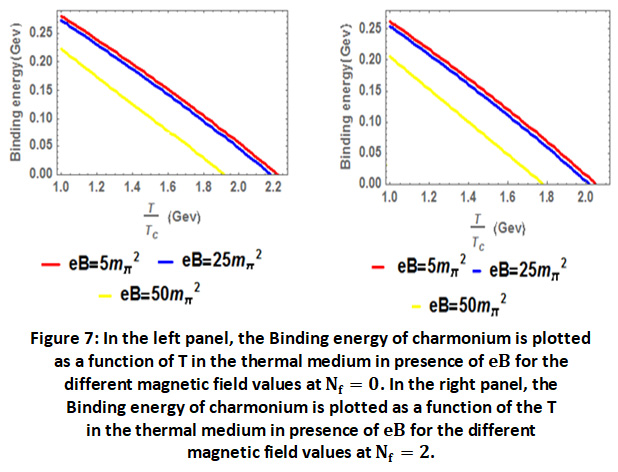 |
Figure 7: In the left panel, the Binding energy of charmonium is plotted as a function of T in the thermal medium in presence of eB for the different magnetic field values at Nf = 0. In the right panel, the Binding energy of charmonium is plotted as a function of the T in the thermal medium in presence of eB for the different magnetic field values at Nf = 2. Click here to view Figure |
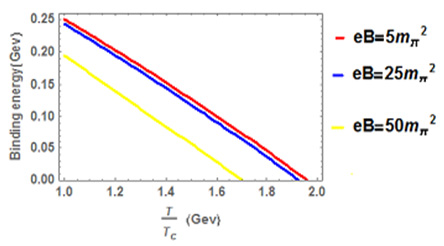 |
Figure 7(a): Click here to view Figure |
In the lower panel, the Binding energy of charmonium is plotted as a function of T in the thermal medium in the presence of the eB for the different magnetic field values at Nf = 3.
In Fig.(8), we have plotted binding energy of charmonium at temperature T=1.98 Tc, T=1.99 Tc, and T=2 Tc as a function of the magnetic field. We find that BE decreases with the magnetic field increases. By increasing the temperature, we notice binding energy decreases. This conclusion is in agreement with works16,58.
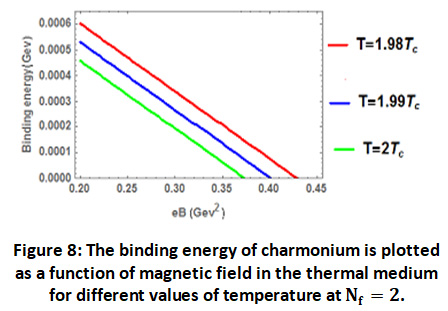 |
Figure 8: The binding energy of charmonium is plotted as a function of magnetic field in the thermal medium for different values of temperature at Nf = 2. Click here to view Figure |
In Fig.(9), bottmonium binding energy is plotted as a function of T for three cases eB = 5 mπ2,eB = 25mπ2 and eB = 50mπ2. By increasing the magnetic field, we notice that binding energy of 1S bottomonium decreases. In the upper left panel, we took Nf = 0. Besides, the binding energy decreases when taking Nf = 2 in the upper right panel. Finally, we find that the BEs decrease with the increase of Nf. At Nf = 3, as shown in the lower panel. As a result, we deduce that the Nf plays a role in the decrease of the BE. This finding is in agreement with works16,50. A similar situation also observed for charmonium, except that the BE for charmonium is higher than that for bottomonium.
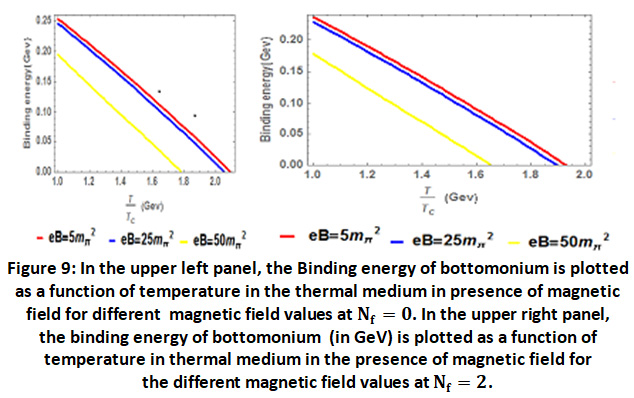 |
Figure 9: In the upper left panel, the Binding energy of bottomonium is plotted as a function of temperature in the thermal medium in presence of a magnetic field for different magnetic field values at Nf = 0. In the upper right panel, the binding energy of bottomonium (in GeV) is plotted as a function of temperature in the thermal medium in the presence of magnetic field for the different magnetic field values at Nf = 2. Click here to view Figure |
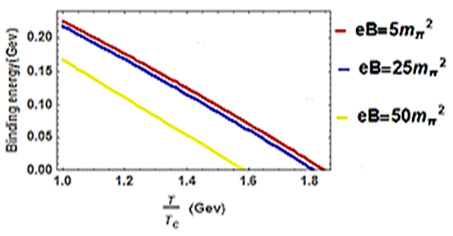 |
Figure 9(a): Click here to view Figure |
In the lower panel, bottomonium Binding energy (in GeV) is plotted as a function of temperature in thermal medium in the presence of magnetic field for the different magnetic field values at Nf = 3.
In Fig.(10), we have plotted binding energy of bottomonium at temperature T=1.98 Tc , T=1.99 Tc, and T=2 Tc as a function of the eB. Note that BE with the eB decreases. By increasing the temperature, we notice binding energy decreases. Also, we note that the binding energy tends to zero that depends on the value of the temperature of the medium. This result is noted in Ref.16,50.
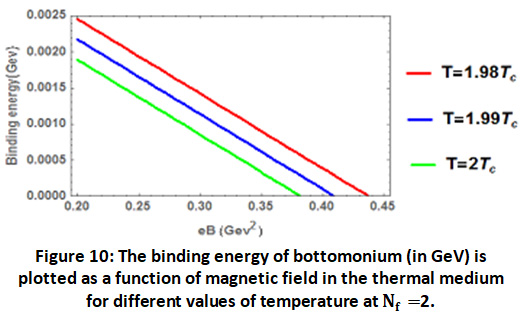 |
Figure 10: The binding energy of bottomonium (in GeV) is plotted as a function of magnetic field in the thermal medium for different values of temperature at Nf = 2. Click here to view Figure |
Dissociation Temperature for Heavy Quarkonia
Over last two decades, the dissociation of the binding state of the two substances in a thermal medium has improved. When the scan became strong enough, it was expected that the resonance would separate. i.e. prospective is too small to carry QQ pair together. Dissociation is presently thought to be predominantly caused by an increase in the resonance distance, or by Landau damping, an inelastic mechanism of spatially mediated dispersion by a patron such as gluons14 or because of a process glue-dissociation in which involves hard thermal gluon in one-tone color state15. When the medium has lower T than BE of the basic resonance, process become dominant. Thus even at lower temperature, the quarkonium is dissociated even at lower temperatures where likelihood of color processing is small.
The dissociation temperature is calculated in this work at Eb, an approximation that gives worthy accuracy in computation of dissociation temperature. Using the predicted binding energies, we investigate effect of eB on the dissociation temperature for charmonium & bottomonium in presence of hot medium.
In Table (1), the dissociation temperature (TD) is the minimum when the magnetic field at eB=50 mπ2. When Nf = 0, the charmonium is dissociated at 2.22 Tc when eB=5 mπ2. At the case, eB=25 mπ2 and eB=50 mπ2, are dissociated at 2.19 Tc and 1.91 Tc .When Nf = 2 charmonium is dissociated at 2.05 Tc when eB=5 mπ2, in the case, eB=25 mπ2 and eB=50 mπ2, are dissociated at 2.01 Tc and 1.77 Tc. We notice that TD, in this case is lower compared to Nf = 0. When Nf = 3 charmonium is dissociated at 1.96 Tc when eB=5 mπ2, in the case, eB=25 mπ2 and eB=50 mπ2 are dissociated at 1.93 Tc and 1.7 Tc.
Table 1: Dissociation Temperature (TD) for Charmonium.
|
State |
eB=5 mπ2 |
eB=25 mπ2 |
eB=50 mπ2 |
|
Nf=0 |
2.22 Tc |
2.19 Tc |
1.91 Tc |
|
Nf=2 |
2.05 Tc |
2.01 Tc |
1.77 Tc |
|
Nf=3 |
1.96 Tc |
1.93 Tc |
1.7 Tc |
In the Table (2), at Nf=0 bottomonium is dissociated with 2.1 Tc when eB=5 mπ2, in the case, eB=25 mπ2 and eB=50 mπ2, are dissociated at 2.05 Tc and 1.79 Tc. When Nf = 2 bottomonium is dissociated at 1.94 Tc when eB=5 mπ2, in the case, eB=25 mπ2 and eB=50 mπ2, are dissociated at 1.9 Tc and 1.65 Tc. We note that TD is lower compared to Nf=0. When Nf = 3 bottomonium is dissociated at 1.85 Tc when eB=5 mπ2, in the case, eB=25 mπ2 and eB=50 mπ2, are dissociated at 1.81 Tc and 1.59 Tc. This conclusion is agreed with Ref.16,50. In Ref.50, In the SE, it is used to the real part of potential and they have found that real part of potential is more screened and by increasing in screening of real part of potential leads to decrease of BEs of Υ and J/Ψ. Finally, they got the TD for Υ and J/Ψ, which became slightly lesser in presence of weak magnetic field. At eB= 0.5mπ2 they dissociated at slightly lower value 1.13Tc & 3.94Tc. In Ref.16, the eB influences binding of J/ψ & χc. it reduces the binding of J/ψ but increases the binding of χc. In the other hand, the magnetic field raises the width of the resonances because the temperature is too high. We eventually obtained the dissociation due to the Landau damping and noted that the TD had risen in the presence of a eB. At eB = 6mπ2 the J/ψ is dissociated at 2 Tc, and with eB = 4m2π, the χc is dissociated at 1.1 Tc. As the eB increases further the TD decreases.
Table 2: Dissociation Temperature (TD) for Bottomonium.
|
State |
eB=5 mπ2 |
eB=25 mπ2 |
eB=50 mπ2 |
|
Nf=0 |
2.1 Tc |
2.05 Tc |
1.79 Tc |
|
Nf=2 |
1.94 Tc |
1.9 Tc |
1.65 Tc |
|
Nf=3 |
1.85 Tc |
1.81 Tc |
1.59 Tc |
Dissociation of Heavy Quarkonia in a Magnetic Field
We calculate the dissociation of charmonium & bottomonium in a magnetic field when Eb-0.
Table 3: Dissociation of Charmonium in the Magnetic Field.
|
cc |
T=2Tc |
T=1.99 Tc |
T=1.98Tc |
|
|
eB=19.4 mπ2 |
eB=21 mπ2 |
eB=22.57 mπ2 |
By taking thermal medium at T=2Tc, we note that the binding energy dissociated as the magnetic field increases eB=19.4 mπ2. By decreasing the temperature of the medium up to T=1.98 Tc, we note that the binding energy dissociated at eB=22.57 mπ2. The state of bottomonium is similar to that states of Table (4) but the dissociation of bottomonium is more than that of charmonium. This conclusion is agreed with works such as that15,59.
Table 4: Dissociation of Bottomonium in the Magnetic Field.
|
bb |
T=2 Tc |
T=1.99 Tc |
T=1.98 Tc |
|
|
eB=19.95 mπ2 |
eB=21.5 mπ2 |
eB=23 mπ2 |
Summary and Conclusion
We use a generalized mD that depends on T and eB to find the dissociation of quarkonia in presence of a strong magnetic field in a hot medium. SE is solved analytically using the NU technique, with the real potential taking into account the finite T and eB effects which are not considered in other works.
We consider the effect of the number of flavors, finite temperature, and magnetic field on binding energy and dissociation temperature. We found that the Nf has a basic role on decreasing binding energy. We have observed that the magnetic field is largely affected by large-distance interaction, as a result of which the real part of the potential is more attractive. We report on the results for the values of the magnetic field at eB=5 mπ2, eB=25mπ2 and eB=50 mπ2. We found the binding energy decreases by increasing the magnetic field. Also, we measure that the TD is above critical temperature Tc=0.17 GeV, & thatTD of charmonium & bottomonium is lower in a strong magnetic field. This occurs because of the BE decreases by increasing the magnetic field. We note that the TD decreases with an increase in the Nf and decrease with magnetic field values. We note that the dissociation temperature the of charmonium is greater than that of the bottomonium since the mass of charmonium is smaller than the mass of the bottomonium. This conclusion is agreed with results of Refs.16,46,50,59. We hope to include the effect of fractional parameters as future work.
Acknowledgment
The authors would like to thank Faculty, science, Menoufia University.
Funding Source
There is no funding or financial support for this research work.
Conflict of Interest
Declare there is no conflict of interest in the manuscript.
References
- J. C. Collins and M. J. Perry, Phys. Rev. Lett, 34, (1975), 1353.
CrossRef - N. Cabibbo and G. Parisi, Phys. Lett. B. 59. (1975), 67–69.
CrossRef - I. A. Shovkovy, Lect. Notes Phys. 871 2013), 13.
CrossRef - M. D: Elia, Lect. Notes Phys. 871 (2013), 181
- K. Fukushima, Lect. Notes Phys. 871 (2013), 241.
- N. Muller, J. A. Bonnet, and C. S. Fisher, Phys. Rev. D 89 (2014), 094023.
- V. A. Miransky and I. A. Shovkovy, Phys. Rep. 576 (2015), 1-209.
CrossRef - D. Kharzeev, L. McLerran, and H. Warringa, Nucl. Phys. An 803 (2008), 227.
CrossRef - T. Vachaspati, Phys. Lett. B 265 (1991), 258.
CrossRef - M. Abu-Shady, Int. J. Mod. Phys. Appl. 49 (2018), 1708 .
- M. Abu-Shady, H. M. Fath-All, Int. J. Mod. Phys. 35 (2020), 2050110.
CrossRef - M. Abu. Shady, and A. N. Ikot, Eur. Phys. J. Plus 134 (2019), 321.
CrossRef - D. L. Yang and B. Muller, J. Phys. G 39 (2012)., 015007.
CrossRef - M. Laine, O. Philipsen, M. Tassler, P. Romatschke, J. High Energy Phys. (2007) 03.
CrossRef - N. Brambilla, M. A. Escobedo, J. Ghiglieri, A. Vairo, J. High Energy Phys. 1305 (2013).
CrossRef - M. Hasan, B. K. Patra, P. Bagchi, Nucl. Phys. A 955 (2020), 121688.
CrossRef - T. D. Cohen, D.A. McGady, E.S. Werbos, Phys. Rev. C 76 (2007), 055201.
CrossRef - J. O. Andersen, Phys. Rev. D 86 (2012), 025020.
CrossRef - J. O. Andersen, JHEP1210 (2012)., 005.
CrossRef - S. P. Klevansky, R.H. Lemmer, Phys. Rev. D 39 (1989), 3478.
CrossRef - D. P. Menezes, M. Benghi Pinto, S. S. Avancini, C. Providencia,Phys. Rev. C 80 (2009)., 065805.
CrossRef - R. Gatto, M. Ruggieri, Phys. Rev. D 83 (2011)., 034016.
CrossRef - R. Gatto, M. Ruggieri, Phys. Rev. D 82 (2010)., 054027.
CrossRef - K. Kashiwa, Phys. Rev. D 83 (2011)., 117901.
CrossRef - J. O. Andersen, R. Khan, Phys. Rev. D 85, 065026 (2012).
CrossRef - S. S. Avancini, D. P. Menezes, M. B. Pinto, and C.Providencia arXiv:1202.5641 (2012).
- K. Fukushima and J. M. Pawlowski, arXiv:1203.4330 (2012).
- A. J. Mizher, M.N. Chernodub, E.S. Fraga, Phys. Rev. D 82 (2010)., 105016.
CrossRef - J. O. Andersen, A. Tranberg, JHEP 08,002 (2012).
CrossRef - S. Kanemura, H.-T. Sato, H. Tochimura, Nucl. Phys. B 517 (1998), 567.
CrossRef - K. G. Klimenko, Theor. Math. Phys. 90 (1992), 1.
CrossRef - J. Alexandre, K. Farakos, G. Koutsoumbas, Phys. Rev. D 63 (2001),065015.
CrossRef - D. D. Scherer, H. Gies, Phys. Rev. B 85 (2012), 195417.
CrossRef - C. V. Johnson, A. Kundu, JHEP 12 (2008)., 053.
CrossRef - F. Preis, A. Rebhan, A. Schmitt, JHEP 1103 (2011), 033.
CrossRef - A. J. Mizher, E. S. Fraga, M. Chernodub, PoS FACESQCD 020 (2010).
- E. S. Fraga, L. F. Palhares, Phys. Rev. D 86 (2012), 016008.
CrossRef - K. Marasinghe and K. Tuchin, Phys. Rev. C 84 (2011)., 044908.
CrossRef - J. Alford and M. Strickland, Phys. Rev. D 88 (2013)., 105017.
CrossRef - S. Cho, K. Hattori, S. H. Lee, K. Morita, and S. Ozaki, Phys. Rev. Lett.113, 172301(2014).
CrossRef - X. Guo, S. Shi, N. Xu, Z. Xu and P. Zhuang, Phys. Lett. B 751, 215 (2015).
CrossRef - C. Bonati, M. D’Elia and A. Rucci, Phys. Rev. D 92, 054014 (2015).
CrossRef - R. Rougemont, R. Critelli and J. Noronha, Phys. Rev. D 91, 066001 (2015).
CrossRef - D. Dudal and T. G. Mertens, Phys. Rev. D 91, 086002 (2015).
CrossRef - A. V. Sadofyev and Y. Yin, arXiv:1510.06760.
- M. Hasan, B. Chatterjee, B. K. Patra, Eur. Phys. J. C 77, 767 (2017).
CrossRef - Af. Nikiforov Uvarov, "Special Functions of Mathematical Physics" Birkhauser, Basel (1988).
CrossRef - S. M. Kuchin and N. V. Maksimenko, Univ. J. Phys. Appl.7, 295 (2013).
CrossRef - R. Kumar and F. Chand, Commun. Theor. Phys. 59, 528 (2013).
CrossRef - M. Hasan, B. K. Patra, Phys. Rev. D 102, 036020 (2020).
CrossRef - E. J. Ferrer, V. de la Incera and X. J. Wen, Phys. Rev. D 91, 054006 (2015).
CrossRef - Yu. A. Simonov, Phys. At. Nucl. 58, 107 (1995).
CrossRef - M. A. Andreichikov, V. D. Orlovsky and Yu. A. Simonov, Phys. Rev. Lett. 110, 162002 (2013).
CrossRef - J. Beringer, Particle Data Group, Review of Particle Physics, Phys. Rev. D 86, 010001 (2012).
- V. K. Agotiya, V. Chandra, M. Y. Jamal and I. Nilima, Phys. Rev. D 94, 094006 (2016).
CrossRef - A. Al-Jamel, Mod. Phys. Lett. A, Vol. 34, No. 37, 1950307 (2019).
CrossRef - A. Bandyopadhyay, C. A. Islam, M. G. Mustafa, arxiv: 1602.06769V3 (2017).
- S. A. Khan, B. K. Patra, and M. Hasan, arxiv: 2004.08868V1 (2020).
- P. Bagchi, N. Dutta, B. Chatterjee, S. P. Adhya, arxiv: 1805.04082V1 (2018).
- F. Mebarek-Oudina et al. International Journal of Numerical Methods for Heat & Fluid Flow (2020).
- S. Marzougui et al. International Journal of Numerical Methods for Heat & Fluid Flow (2021).
- P. K. Dadheech et al. Journal of Nanofluids 9.3 (2020): 161-167.
CrossRef - S.M. Abo-Dahab, M.A., Abdelhafez, F. Mebarek-Oudina et al. Indian J. Phys. (2021). https://doi.org/10.1007/s12648-020-01923-z.
CrossRef

This work is licensed under a Creative Commons Attribution 4.0 International License.





